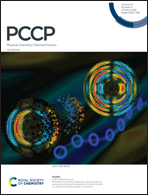Lipid bilayers as potential ice nucleating agents†
Abstract
Cellular damage is a key issue in the context of cryopreservation. Much of this damage is believed to be caused by extracellular ice formation at temperatures well above the homogeneous freezing point of pure water. Hence the question: what initiates ice nucleation during cryopreservation? In this paper, we assess whether cellular membranes could be responsible for facilitating the ice nucleation process, and what characteristics would make them good or bad ice nucleating agents. By means of molecular dynamics simulations, we investigate a number of phospholipids and lipopolysaccharide bilayers at the interface with supercooled liquid water. While these systems certainly appear to act as ice nucleating agents, it is likely that other impurities might also play a role in initiating extracellular ice nucleation. Furthermore, we elucidate the factors which affect a bilayer's ability to act as an ice nucleating agent; these are complex, with specific reference to both chemical and structural factors. These findings represent a first attempt to pinpoint the origin of extracellular ice nucleation, with important implications for the cryopreservation process.

- This article is part of the themed collection: 2022 PCCP HOT Articles


 Please wait while we load your content...
Please wait while we load your content...